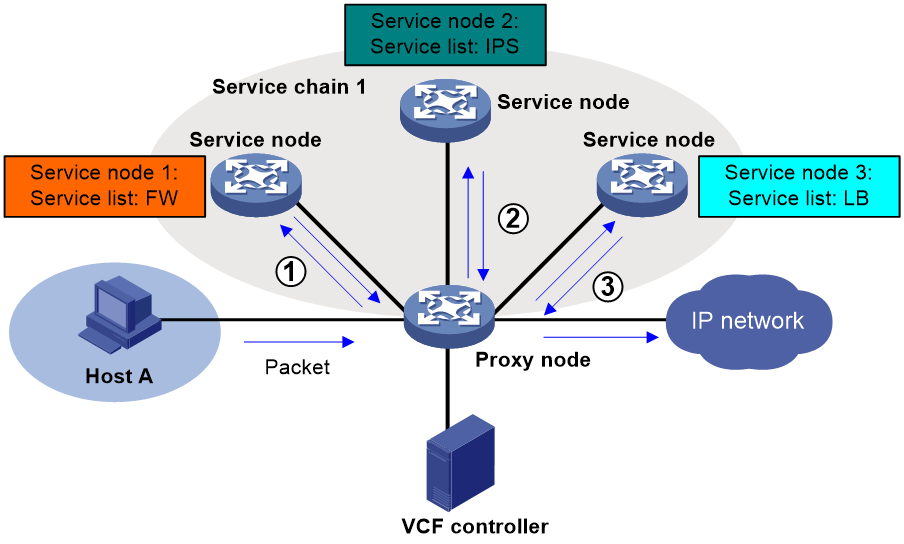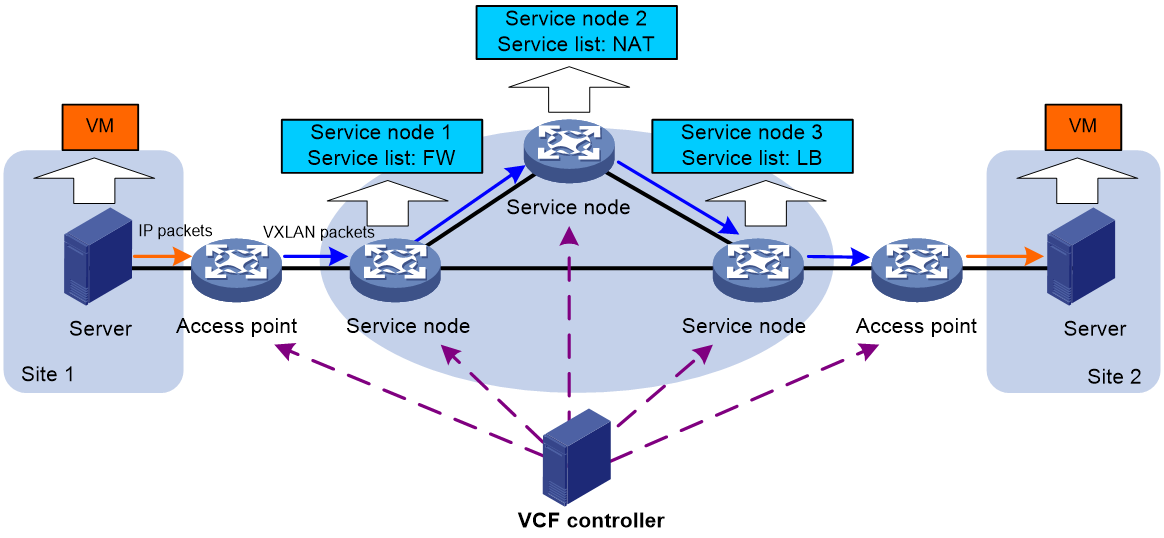- Table of Contents
- Related Documents
-
| Title | Size | Download |
|---|---|---|
| 01-Service chain configuration | 96.33 KB |
Configuring service chains
Overview
Service chain is a forwarding technology used to guide network traffic through service nodes. It is based on the Overlay technology and combines the software defined network (SDN) centralized management theory. You can configure service chains by using a virtual converged framework controller (VCFC).
The switch can act as a proxy node or an access point in a service chain.
Service chain functions
Service chain implements the following functions:
· Decoupling the tenant logical network and the physical network, and separating the control plane from the forwarding plane.
· Service resource allocation and deployment on demand with no physical topology restrictions.
· Dynamic creation and automatic deployment of network function virtualization (NFV) resource pools.
· Tenant-specific service arrangement and modification without affecting the physical topology and other tenants.
Using the switch as a proxy node
Network framework
Figure 1 shows the framework of a service chain network with the switch acting as a proxy node.
The service chain has the following types of nodes:
· Proxy node—A switch that uses service chain policies deployed by a VCFC to determine whether to forward a packet into a service chain.
· Service node—A physical device or a NFV device that applies services to the received traffic. A service chain can contain multiple service nodes.
The switch can act only as a proxy node but it cannot act as a service node.
How it works
The VCFC deploys service chain policies to the proxy node based on different tenant applications. The proxy node uses the service chain policies to perform packet forwarding and service chain processing as follows:
1. When the proxy node receives an IP packet, it uses a service chain policy to verify whether the packet is qualified to enter a service chain.
¡ If the packet is qualified, the proxy node forwards the packet to a service node.
¡ If the packet is not qualified, the proxy node forwards the packet without service chain processing.
2. When the service node receives the packet, it processes the packet and then forwards it back to the proxy node.
3. When the proxy node receives the packet, it verifies whether the packet is qualified to enter another service chain.
This procedure is repeated so that the packet can be processed by different service nodes.
Using the switch as an access point
Network framework
Figure 2 shows the framework of a service chain network with the switches acting as access points.
The service chain has the following types of nodes:
· Access point—A switch that acts as a VXLAN tunnel end point (VTEP). It uses routing policies deployed by the VCFC to verify whether a packet is qualified to enter a service chain. If the packet is qualified, the access point encapsulates the packet into a VXLAN packet.
· Service node—A physical device or a NFV device that applies services to the received traffic. A service chain can contain multiple service nodes.
Packet format
Figure 3 shows the format of a VXLAN packet that carries service chain information.
A service chain uses the following fields in the VXLAN header to identify packets:
· Flags—When the S bit is set to 1, the Service chain field is valid. When the S bit is set to 0, the Service chain field is invalid.
· Service chain—A 24-bit field that includes the D bit and service path ID. When the D bit is set to 0, the packet is a forward packet. When the D bit is set to 1, the packet is a reverse packet. The 23-bit service path ID is used to identify a service chain.
How it works
The VCFC deploys routing policies to access points and service nodes based on different tenant applications. The access points and the service nodes use the routing policies to perform packet forwarding and service chain processing as follows:
1. When an access point receives an IP packet, it uses the routing policy to verify whether the packet is qualified to enter a service chain.
¡ If the packet is qualified, the access point encapsulates the packet into a VXLAN packet and adds service chain information to the VXLAN header. The packet is then forwarded to a service node.
¡ If the packet is not qualified, the access point forwards the packet without service chain processing.
2. When the service node receives the VXLAN packet, it performs the following tasks:
a. Decapsulates the packet.
b. Performs a local lookup for a service chain matching the service path ID in the VXLAN header of the packet. If a match is found, the service node applies the service to the packet.
c. Encapsulates the packet into a VXLAN packet and adds service chain information to the VXLAN header of the packet according to the routing policy.
d. Forwards the packet to the next service node.
3. After the last service node completes processing the packet, it encapsulates the packet into a VXLAN packet without adding service chain information to the VXLAN header. The packet is then forwarded to the peer access point.
Configuring a service chain
You can configure a service chain only by using a VCFC. For more information, see the VCFC configuration guide.




